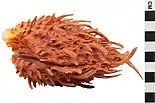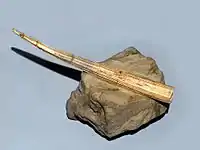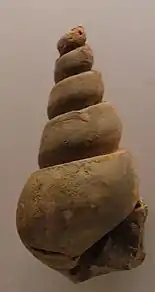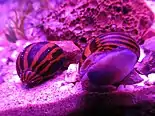Hasle Formation
The Hasle Formation is a geologic formation on the island on Bornholm, Denmark. It is of early to late Pliensbachian age. Vertebrate fossils have been uncovered from this formation.[2][3] The type section of the formation is found at the south of the costal Hasle Town, and it is composed by rusty yellow to brownish siltstones and very fine-grained sandstones. The southernmost arch, Hvjdoddebuen, is not as fossil-bearing as the type unit in Hasle.[4] The formation can be separated in two different petrographic types: type 1 sandstones are friable with layers and lenses of concretionary siderite and type 2 well-cemented sandstones.[5] Both types where deposited in a relatively high-energy marine environment with a diagenetic pattern that demonstrates a close relation to various phases of subsidence and uplift in the tectonically unstable Fennoscandian Border Zone.[5] Most of its deposition happened on a storm-dominated shoreface, with the exposed parts deposited in an open marine shelf within 1–2 km distance from the fault-controlled coastlines.[6] However, recent works have recovered terrestrial fauna from it, including a footprint, suggesting easterly winds and low tide could have exposed the inner parts of the upper shoreface, and create long-lasting Floodplain-type environments.[7] Field works since 1984 have shown a mostly hummocky cross-stratified deposition, with great complexity of the sediments that suggests very complicated and variable flow conditions, with Megaripples derived from storm events.[8] Storms were frequent and the coastline faced a wide epeiric sea with a fetch towards the west of possibly 1000 kilometers.[8] The Jamesoni–Ibex Chronozone in the Central European Basin represents a clear sea Transgression, due to the appearance of ammonites from Thuringia and southern Lower Saxony, showing a full marine ingression towards the west.[9] This rise in the sea level is also measured in the north, as is proven by the presence of Uptonia jamesoni in Kurremölla (Röddinge Formation, Skåne) and Beaniceras centaurus plus Phricodoceras taylori on the Hasle Formation.[9] The whole Hasle Sandstones are a result of this rise in the sea level, where the marine sediments cover the deltaic layers of the Rønne Formation.[9] The rise in the sea level is observed on palynology, as on the Hasle Formation Nannoceratopsis senex (Dinoflajellate) and Mendicodinium reticulaturn (Algae Acritarch) appear, indicating a transition from paralic and restricted marine to fully marine.[10]
| Hasle Formation | |
|---|---|
| Stratigraphic range: Lower to Middle Pliensbachian ~Jamesoni–Margaritatus Chronozone | |
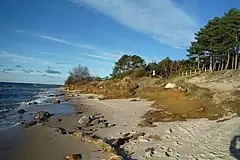 Outcrop (Yellow layers) | |
| Unit of | Bornholm Group |
| Underlies | Sorthat Formation |
| Overlies | Rønne Formation |
| Thickness | 80–140 m (260–460 ft) |
| Lithology | |
| Primary | Siltstone, sandstone |
| Location | |
| Coordinates | 55.2°N 14.7°E |
| Approximate paleocoordinates | 45.0°N 18.5°E |
| Region | Bornholm |
| Country | |
| Type section | |
| Named for | Hasle, Bornholm |
| Named by | Gry[1] |
| Year defined | 1969 |
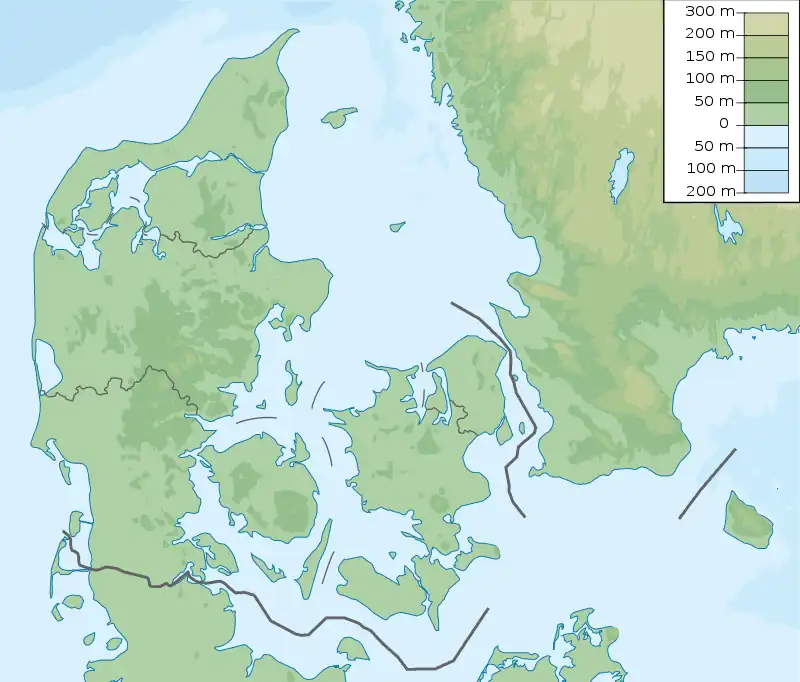 Hasle Formation (Denmark) | |
Fossil content
Annelida
| Genus | Species | Location | Material | Notes | Images |
|---|---|---|---|---|---|
|
|
Trace fossils; polychaete encrusters in rock |
A sessile, marine annelid tube worm of the family Serpulidae. Its affinities with the genus Serpula are controversial, since the genus is known mostly since Cretaceous strata. Although there are other fossils assigned to the genus on same age deposits of France.[13] |
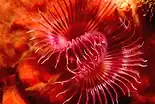 Head of a modern Serpula vermicularis | |
Brachiopoda
| Genus | Species | Location | Material | Notes | Images |
|---|---|---|---|---|---|
|
|
Cunchs |
A saltwater Brachiopodan, member of Rhynchonellata inside Rhynchonellida. Found associated with Plicatula on long-term well-oxygenated conditions within the substrate and bottom waters. |
| |
|
|
Cunchs |
A Saltwater lamp shell Brachiopodan, member of Terebratulidae inside Terebratulida. The specimens are rather incomplete. The genus is a possible junior synonym of Terebratula. |
_flavascens.jpeg.webp) | |
Bivalvia
| Genus | Species | Location | Material | Notes | Images |
|---|---|---|---|---|---|
|
|
|
A saltwater pearl oyster, member of the family Pteriidae inside Ostreida. Some specimens are big and found associated with Burrow-filled surfaces. This well-known species occurs extremely frequently; Copies occur at all ages, as well as right-handers Left shells have been found. |
||
|
|
|
A saltwater Oyster, member of the family Bakevelliidae inside Ostreida. Found on a series of incomplete Stone Cores filled with specimens, that by Size and Form can be possibly attributable to Gervilleia aerosa. |
| |
|
|
|
A saltwater Oyster, member of the family Ostreinae inside Ostreida. Identified originally as Ostrea semiplicata |
||
|
|
|
A saltwater Clam, type member of the family Cucullaeidae inside Arcida. |
||
|
|
|
A saltwater Clam, type member of the family Parallelodontidae inside Arcida. This species occurs frequently and varies a lot |
||
|
|
|
A saltwater Clam, type member of the family Astartidae inside Carditida. It is found on small, smooth Clam associations, with the exception of one does section, with less well-preserved stone cores and imprints. |
| |
|
|
|
A saltwater Clam, type member of the family Tancrediidae inside Carditida. Tancredia lineata Is based on six shell cores, of which one complete, the others a little defective at the front end. |
||
|
|
|
A saltwater Clam, type member of the family Cardiidae inside Carditida. Is a frequently occurring Clam. |
| |
|
Cyprina[4] |
|
|
|
A saltwater Clam, member of the family Arcticidae inside Veneroidei. Is a frequently occurring Clam. |
|
|
Cypricardia[14] |
|
|
|
A saltwater Clam, member of the family Trapezidae inside Veneroidei. |
|
|
|
|
A saltwater Clam, type member of the family Lucinidae inside Lucinida. Three Stone Cores show perfect Compliance with Regard to Hinge Building and Muscle Impressions Appearance. |
||
|
|
|
A saltwater Clam, type member of the family Pleuromyidae inside Pholadida. Three specimens of this species have been found. |
||
|
|
|
A saltwater file Clam, type member of the family Limidae inside Pectinida. Lima succincta is based on a single fragment of cunch, but enough complete to be certain to be attributed to it. |
| |
|
|
|
A saltwater file Clam, member of the family Limidae inside Pectinida. Mostly know due to a single young individual, but there are also a number of stone cores and imprints of adult Specimens of this species that appear to have been common. |
| |
|
|
|
A saltwater Clam, member of the family Kalenteridae inside Cardiida. One of the most frequent and characteristic Fossils in the layer is this kind, of which especially the hinge part in Imprints and Stone Cores are extremely common. The largest specimen has reached a length of 53 mm, with a width of 39 mm. Myoconcha jespersenii does not occur as frequently as Myoconcha stampensis, with less than 50 specimens, of which, however, none is complete; most occur as stone cores. |
| |
|
|
|
A saltwater tellin Clam, member of the family Tellinidae inside Cardiida. |
| |
|
|
|
A saltwater nut Clam, type member of the family Nuculidae inside Nuculida. Two copies of a Nucula (leda?) so closely in accordance with Moberg's depictions and description of occurring at Kurremolla. |
| |
|
|
|
A saltwater pointed nut Clam, type member of the family Nuculanidae inside Nuculida. Nuculana bornholmiensis is a very common genus only found locally. Nuculana subovalis occurs less and is highly variable in size and appearance. 10 more or less complete specimens of a large Nuculana species must be attributed to Nuculana complanata. |
| |
|
|
|
A saltwater pointed nut Clam, type member of the family Nuculanidae inside Nuculida. |
||
|
|
|
A saltwater Scallop, type member of the family Pectinoidae inside Pectinida. This species has been exceedingly frequent, and numerous Fragments are available. Found by some Fragments with the complete cunch preserved have made the provision quite safe. While the presence of Pecten priscus is quite certain, is the Diagnosis of Pecten aequivalvis is a little controversial, due to be based on shell fragments. |
| |
|
|
|
A saltwater Scallop, member of the family Pectinoidae inside Pectinida. A Pair of incomplete specimens of a Hinnites are known and probably match with the species Hinnites tumidus; however, the state of preservation is bad, with the assignment rather uncertain. |
| |
|
|
|
A saltwater Scallop, member of the family Pectinoidae inside Pectinida. |
| |
|
|
|
A saltwater Scallop, type member of the family Plicatulidae inside Pectinida. Two poorly preserved specimens have been found. |
||
|
|
|
A saltwater Mussel, member of the family Mytilidae inside Mytilida. |
||
|
|
|
A saltwater Mussel, type member of the family Mytilidae inside Mytilida. |
||
|
|
|
A saltwater Mussel, type member of the family Mytilidae inside Mytilida. |
||
Scaphopoda
| Genus | Species | Location | Material | Notes | Images |
|---|---|---|---|---|---|
|
|
|
A saltwater tusk shell (Scaphopoda), member of the family Dentaliidae inside Dentaliida. Dentalium etalense is very common on the Transgression deposits of Korsodde. Three specimens are somewhat different from Dentalium etalense, as they have strongly pronounced transverse striation and do not present any curvature. The thickness is also slightly greater than in Dentalium etalense. |
| |
Gastropoda
| Genus | Species | Location | Material | Notes | Images |
|---|---|---|---|---|---|
|
|
|
A saltwater Snail, type member of the family Acteoninidae inside Prosobranchia. Of this small species there are quite a few specimens, both stone cores and imprints that perfectly allow identifying the species. |
||
|
Amberlya[14] |
|
|
|
A saltwater Snail, type member of the family Spirostylidae inside Murchisoniina. |
|
|
|
|
A saltwater Snail, member of the family Pyramidellidae inside Pyramidelloidea. Two Specimens of a Turritella-like Gastropod found locally have been refer to the Genus. Chemnitzia citharella includes ten specimens, the largest of the genus found locally. However, most of the specimens are shell cores. |
| |
|
|
|
A saltwater Snail, type member of the family Eucyclidae inside Seguenzioidea. Of this genus there are, in addition to a number of smaller ones, well-preserved stone cores, three imprints. Since the material available is rather poor, it is difficult to assign the specimens found to a definite species. |
||
|
|
|
A saltwater Snail, member of the family Turbinidae inside Turbinoidea. Occurs frequently, especially on marine ingression surfaces. |
||
|
|
|
A saltwater moon Snail, type member of the family Naticidae inside Naticoidea. |
| |
|
|
|
A saltwater Snail, type member of the family Neritidae inside Neritoidea. |
| |
|
|
|
A saltwater Snail, type member of the family Pleurotomariidae inside Pleurotomarioidea. Stone cores are extremely common, now and then imprints of this Art. Of course, it is uncertain, yes often ullmligt, to determine a kind of the stone core alone; but in many cases, the upper side has shown those characteristics of this species. |
| |
|
|
|
A saltwater top Snail, type member of the family Trochidae inside Trochoidea. Rare compared with other species found locally. |
||
Belemnites
| Genus | Species | Location | Material | Notes | Images |
|---|---|---|---|---|---|
|
|
|
A belemnite, incertae sedis member of the family Belemnitida. Frequently shows the embryonic chamber preserved as a bladder, slightly bent forward-towards the ventral side. |
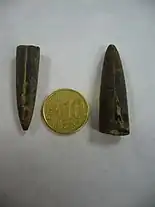 | |
|
|
|
A Belemnite, member of the family Hastitidae inside Belemnitida. |
||
Ammonites
| Genus | Species | Location | Material | Notes | Images |
|---|---|---|---|---|---|
|
Acanthopleuroceras? sp. indet.[3] |
|
specimens[3] |
A possible Ammonite of the family Polymorphitidae inside Ammonitida. |
||
|
Aegoceras armatum[3] |
specimens[3] |
An Ammonite of the family Liparoceratidae inside Ammonitida. Later renamed Beaniceras centaurus, senior synonym of Aegoceras centaurus[3] |
_(Lower_Jurassic).jpg.webp) | ||
|
Aegoceras centaurus[3] |
specimens[3] | ||||
|
Aegoceras capraius[3] |
specimens[3] | ||||
|
Aegoceras mangenesti[3] |
specimens[3] | ||||
|
Aegoceras pettos[3] |
specimens[3] |
Junior synonym of Coeloceras pettos, possible synonym of Coeloceras grenouillouxi[3] | |||
|
Apoderoceras aculeatum[3] |
specimens[3] |
An Ammonite of the family Polymorphitidae inside Ammonitida. |
|||
|
Arnioceras falcaries[3] |
specimens[3] |
An Ammonite of the family Arietitidae inside Ammonitida. |
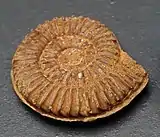 | ||
|
Beaniceras centaurus[3] |
specimens[3] |
An Ammonite of the family Liparoceratidae inside Ammonitida. Senior synonym of Aegoceras centaurus[3] |
|||
|
Coeloceras[3] |
Coeloceras pettos[3] |
specimens[3] |
An Ammonite of the family Coeloceratidae inside Psilocerataceae. Senior synonym of Aegoceras pettos. Possible junior synonym of Coeloceras grenouillouxi[3] |
||
|
Coeloceras grenouillouxi[3] |
specimens[3] |
Possible senior synonym of Coeloceras pettos[3] |
|||
|
Paramicroderoceras[3] |
Paramicroderoceras fila[3] |
specimens[3] |
An Ammonite of the family Juraphyllitidae inside Phylloceratina. |
||
|
Paramicroderoceras? sp indet[3] |
specimens[3] |
||||
|
Phylloceras loscombii[3] |
specimens[3] |
An Ammonite of the family Juraphyllitidae inside Phylloceratina. |
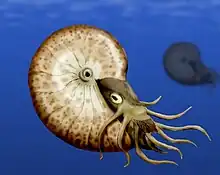 | ||
|
Phricodoceras taylori[3] |
specimens[3] |
An Ammonite of the family Phricodoceratidae inside Psilocerataceae. |
|||
|
Platypleuroceras[3] |
Platypleuroceras brevispina[3] |
specimens[3] |
An Ammonite of the family Polymorphitidae inside Ammonitida. |
||
|
Platypleuroceras submulticum[3] |
specimens[3] |
||||
|
Platypleuroceras caprarium[3] |
specimens[3] |
||||
|
Platypleuroceras spp. indet[3] |
specimens[3] |
||||
|
Radstockiceras hechingense[3] |
specimens[3] |
An Ammonite of the family Oxynoticeratidae inside Psilocerataceae. |
|||
|
Tragophylloceras numismale[3] |
specimens[3] |
An Ammonite of the family Juraphyllitidae inside Phylloceratina. |
|||
|
Tragophylloceras sp[3] |
specimens[3] |
||||
|
Uptonia lata[3] |
specimens[3] |
An Ammonite of the family Polymorphitidae inside Ammonitida. |
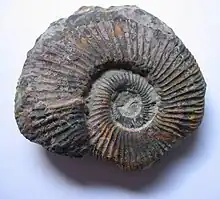 | ||
|
Uptonia sp indet[3] |
specimens[3] |
||||
Chondrichthyes
Unidentified fin spines are known from this formation.[2]
| Genus | Species | Location | Material | Notes | Images |
|---|---|---|---|---|---|
| Acrodus[11][12] | Acrodus minimus | Stampeå stream | Large number of teeth | A marine shark, member of the family Acrodontidae inside Hybodontiformes. | |
| Agaleus[2] | Agaleus dorsetensis[2] | Hasle Harbour | Four teeth | A marine shark, type member of the family Agaleidae inside Euselachii. This genus may have been a suction feeder as its anterior teeth are similar to those of extant nurse sharks. | |
| Hybodontidae[2] | Hybodontidae Indeterminate | Hasle Harbour | One incomplete spine | A marine shark, incertae sedis inside Hybodontiformes. | |
| Hybodus[2] | Hybodus reticulatus[2] | Hasle Harbour | 21 incomplete crowns | A marine shark, type member of the family Hybodontidae inside Hybodontiformes. | 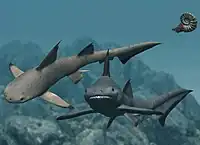 |
| Hybodus delabechei[2] | Hasle Harbour | Three complete crowns | A marine shark, type member of the family Hybodontidae inside Hybodontiformes. Its teeth suggest that it may have been feeding on shelly invertebrates. | ||
| Lissodus | Lissodus hasleensis[2] | Hasle Harbour | Four complete teeth | A marine/brackish shark, member of the family Lonchidiidae inside Hybodontiformes. | 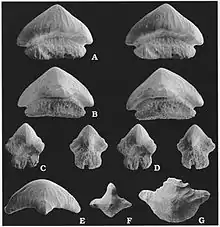 |
| Myriacanthidae | Undetermined[15] | Tooth plates.[15] | Indeterminate tooth plates of marine chimaeras. | ||
| Myriacanthus[16][17] | Myriacanthus paradoxus[15] | Cliff section 100 m south of Hasle, Bornholm.[15] | Tooth plates.[15] | A marine chimaera. | |
| Myriacanthus sp.[17] | Hasle Harbour | Isolated tooth plate | A marine Chimaera, type member of the family Myriacanthidae inside Chimaeriformes. | ||
| Paraorthacodus[2] | Paraorthacodus sp[2] | Hasle Harbour | Two incomplete teeth | A marine shark, member of the family Palaeospinacidae inside Synechodontiformes. | |
| Oblidens[17][15] | Oblidens bornholmensis[17][15] | Hasle Harbour; cliff section 100 m south of Hasle Harbour.[15] | Multiple tooth plates.[17][15] | A marine Chimaera, member of the family Myriacanthidae inside Chimaeriformes. | |
| Synechodus[2] | Synechodus occultidens[2] | Hasle Harbour | Four incomplete teeth | A marine shark, type member of the family Palaeospinacidae inside Synechodontiformes. | |
Actinopteri
| Genus | Species | Stratigraphic position | Material | Notes | Images |
|---|---|---|---|---|---|
|
Archaeotolithus[18] |
|
|
Otoliths |
Interpreted as sagittal otoliths of a Palaeonisciformes Indet.[19] Fish Otoliths, originally assigned to the extant family Sciaenidae, then from members of Palaeoniscidae and some other research suggest affinities with Pholidophoriformes. |
|
|
|
Teeth |
A marine/brackish Osteichthyes, representative of the family Saurichthyidae inside Chondrostei. Was identified as Saurichthys. Of this characteristic Genus were found 3 teeth, resembling superficially Saurichthys acuminata, and a third that looks more like belonging to Saurichthys longidens. |
.jpg.webp) Saurichthys model | |
Sauropterygia
| Genus | Species | Material | Notes | Images | |
|---|---|---|---|---|---|
|
|
|
A marine plesiosaur, member of the family Plesiosauroidea inside Sauropterygia. |
||
|
|
Tooth |
A marine plesiosaur, member of the family Plesiosauroidea inside Sauropterygia. |
||
|
|
Fourteen isolated teeth |
A marine plesiosaur, member of the family Pliosauroidea inside Sauropterygia. Resembles Attenborosaurus. |
||
|
Tooth |
A marine plesiosaur, member of the family Rhomaleosauridae inside Sauropterygia. Resembles Rhomaleosaurus. |
|||
Thalattosuchia
| Genus | Species | Location | Material | Notes | Images |
|---|---|---|---|---|---|
|
Teleosauridae Indeterminate |
Hasle Harbour |
DK-1072, a dermal plate |
A Teleosauridae Thalattosuchian. One of the northernmost fossil finds of the group and one of the few of the pliensbachian worldwide, it represents a genus whose dermal armor was similar to the genus Macrospondylus of the Toarcian.[22] |
 Macrospondylus example of Teleosauroid | |
Pterosauria
| Genus | Species | Location | Material | Notes | Images |
|---|---|---|---|---|---|
|
Pterosauria? Indeterminate |
Hasle Harbour |
Uncertain Remains |
A possible Pterosaur. Is quoted the find of a "Flying Reptile" on the Hasle Sandstone by C. Malling at the beginning of the 20th century. No further data related to the find has been published. |
 Example of coeval Pterosaur, Dimorphodon | |
Theropods
| Genus | Species | Location | Material | Notes | Images |
|---|---|---|---|---|---|
|
Neotheropoda Indeterminate |
Hasle Harbour |
Propodial bone, possibly a radius |
Theropod, incertae sedis inside Neotheropoda. Extremely hollow shaft suggests that it most likely belonged to a juvenile member of a theropod dinosaur.[24] |
 Segisaurus a coeval North American genus | |
|
Stenonyx isp. |
Hasle Harbour |
MGUH – 30889, single Footprint[7] |
Theropod Tracks, member of the ichnofamily Anchisauripodidae, incertae sedis inside Theropoda. Considered a very Small Dinosaur, probably a juvenile. The Foot resembles those of young Coelophysis from Ghost Ranch Quarries.[7] Stenonyx footprints had been described from the Early Jurassic Soltykow (Hettangian) and an identical one from Szydlowek (Pliensbachian), linking Southern Sweden, Bornholm and Poland, contiguous during the Early Jurassic and dinosaurs could thus freely roam this large area.[7] |
||
Sauropodomorpha
| Genus | Species | Location | Material | Notes | Images |
|---|---|---|---|---|---|
|
Massopoda Indeterminate |
Hasle Harbour |
DK966, metatarsal, metapodial or a propodial bone |
A Sauropodomorph of uncertain placement, probably a rather basal genus. |
 Mussaurus, a possible relative of DK966 | |
|
Sauropoda Indeterminate |
Hasle Harbour |
DK976, spinous process from a cervical vertebrae |
A Sauropod Sauropodomorph. Assigned to an early actual Sauropods, which also have quite powerful lateral processes whose cervical vertebrae are relatively long. |
||
Synapsida
| Genus | Species | Location | Material | Notes | Images |
|---|---|---|---|---|---|
|
Tritylodontidae Indeterminate |
Hasle Harbour |
Isolated tooth crown |
A Tritylodontoidea Cynognathian. Hasle Formation fossil cannot be confidently placed within any known genus, it can be either a primitive Tritylodont related to specimens that lack post-canines (Yunnanodon, Dianzhongia), or an early derived genus.[24] It is the oldest occurrence of a mammaliamorph in Scandinavia.[24] |
Oligokyphus, a coeval genus | |
See also
- List of fossiliferous stratigraphic units in Denmark
- Neringa Formation, Lithuania
- Pliensbachian formations
- Mizur Formation, North Caucasus
- Blanowice Formation, Southern Poland
- Clarens Formation, South Africa
- Fernie Formation, Canada
- Kota Formation, India
- Los Molles Formation, Argentina
- Mawson Formation, Antarctica
- Rotzo Formation, Italy
- Whiteaves Formation, British Columbia
- Navajo Sandstone, Utah
- Kandreho Formation, Madagascar
- Kota Formation, India
- Cattamarra Coal Measures, Australia
References
- Gry, H.; Jørgart, T.; Poulsen, V. (1969). "Lithostratigraphy and sedimentary evolution of the Triassic, Jurassic and Lower Cretaceous of Bornholm, Denmark". Mineralogisk Mus. 6 (1).
- Rees, J. (1998). "Early Jurassic selachians from the Hasle Formation on Bornholm, Denmark" (PDF). Acta Palaeontologica Polonica. 43 (3): 43–439.
- Donovan, Desmond T.; Surlyk, Finn. "Lower Jurassic (Pliensbachian) ammonites from Bornholm, Baltic Sea, Denmark" (PDF). Geological Survey of Denmark and Greenland Bulletin. 1: 555–583.
- Malling, C. (1914). "De Jespersenske Buelag i Lias paa Bornholm" (PDF). Meddelelser Fra Dansk Geologisk Forening). 4 (1): 265–270. Retrieved 20 October 2021.
- Larsen, Ole Hede; Friis, Henrik (1991). "Petrography, diagenesis and pore-water evolution of a shallow marine sandstone (Hasle Formation, Lower Jurassic, Bornholm, Denmark)". Sedimentary Geology. 72 (3–4): 269–284. Bibcode:1991SedG...72..269L. doi:10.1016/0037-0738(91)90015-6. Retrieved 6 October 2021.
- Michelsen, O.; Nielsen, L. H.; Johannessen, P. N.; Andsbjerg, J.; Surlyk, F. (2003). "Jurassic lithostratigraphy and stratigraphic development onshore and offshore Denmark" (PDF). Geological Survey of Denmark and Greenland (GEUS) Bulletin. 1 (1): 145–216. doi:10.34194/geusb.v1.4651. S2CID 126907584. Retrieved 8 September 2021.
- Milàn, Jesper; Surlyk, Finn (2014). "An enigmatic, diminutive theropod footprint in the shallow marine Pliensbachian Hasle Formation, Bornholm, Denmark" (PDF). Lethaia. 48 (1): 429–435. doi:10.1111/let.12115. Retrieved 6 October 2021.
- Surlyk, Finn; Noe-Nygaard, Nanna (1986). "Hummocky cross-stratification from the Lower Jurassic Hasle Formation of Bornholm, Denmark". Sediment. Geol. 46 (3–4): 259–273. Bibcode:1986SedG...46..259S. doi:10.1016/0037-0738(86)90062-X. Retrieved 6 October 2021.
- Barth, G.; Pieńkowski, G.; Zimmermann, J.; Franz, M.; Kuhlmann, G. (2018). "Palaeogeographical evolution of the Lower Jurassic: high-resolution biostratigraphy and sequence stratigraphy in the Central European Basin". Geological Society, London, Special Publications. 469 (1): 341–369. Bibcode:2018GSLSP.469..341B. doi:10.1144/SP469.8. S2CID 134043668. Retrieved 8 September 2021.
- Surlyk, F.; Arndorff, L.; Hamann, N. E.; Hamberg, L.; Johannessen, P. N.; Koppelhus, E. B.; Petersen, H. I. (1995). "High‐resolution sequence stratigraphy of a Hettangian‐Sinemurian paralic succession, Bornholm, Denmark". Sedimentology. 42 (2): 323–354. doi:10.1111/j.1365-3091.1995.tb02105.x.
- Malling, C.; Grönwall, K. A. (1909). "En fauna i Bornholms Lias". Meddel. Dansk Geol. Foren. 3 (1): 271–308. Retrieved 6 October 2021.
- Malling, C.; Grönwall, K. A. (1912). "En fauna i Bornholms Lias". Geologiska Föreningen i Stockholm Förhandlingar. 34 (3): 366–367. doi:10.1080/11035891209448698.
- Papier, F. (2001). "Die Gundershoffener Klamm". Fossilien. 6 (1): 368–374.
- Malling, C. (1911). "Hasle-Sandstenens alder" (PDF). Meddelelser Fra Dansk Geologisk Forening. 3 (1): 629–631. Retrieved 20 October 2021.
- Duffin, Christopher; Milàn, Jesper (November 2022). "Further holocephalian remains from the Hasle Formation (Early Jurassic) of Denmark". Bulletin of the Geological Society of Denmark. 70: 139–149. doi:10.37570/bgsd-2022-70-10. S2CID 254356926.
- Bonde, N., Andersen, S., Hald, N., & Jakobsen, S.L. 2008: Danekræ – Danmarks bedste fossiler, 225 pp. Gyldendal, Copenhagen.
- Christopher J. Duffin; Jesper Milàn (2017). "A new myriacanthid holocephalian from the Early Jurassic of Denmark" (PDF). Bulletin of the Geological Society of Denmark. 65: 161–170. doi:10.37570/bgsd-2017-65-10.
- Stolley, E.: Über mesozoische Fischotolithen aus Norddeutschland. — 3. Jahresber. d. Niedersächs. Geol. Vereins, 1910
- Schwarzhans, W. (2018). "A review of Jurassic and Early Cretaceous otoliths and the development of early morphological diversity in otoliths". Neues Jahrbuch für Geologie und Paläontologie - Abhandlungen. 287 (1): 75–121. doi:10.1127/njgpa/2018/0707. Retrieved 13 August 2021.
- Rees, J.; Bonde, N. (1999). "Plesiosaur remains from the Early Jurassic Hasle Formation, Bornholm, Denmark". Secondary Adaptation to Life in Water: 13–17.
- Smithy, A. S. (2008). "Plesiosaurs from the Pliensbachian (Lower Jurassic) of Bornholm, Denmark". Journal of Vertebrate Paleontology. 28 (4): 1213–1217. doi:10.1671/0272-4634-28.4.1213. JSTOR 20491054. S2CID 128999502. Retrieved 6 October 2021.
- Milàn, J.; Mueller-Töwe, I. (2021). "En havskrokodille fra Hasles fjerne fortid" (PDF). Natur på Bornholm. 19 (1): 14–16. Retrieved 6 October 2021.
- G. Olsen, Ernst (1950). Bornholms Historie: landbruget og dets biografier (PDF). RØNNE: Ego. p. 15. Retrieved 26 October 2021.
- Molin, E. (2021). "Rare terrestrial vertebrate remains from the Pliensbachian (Lower Jurassic) Hasle Formation on the Island of Bornholm, Denmark". Dissertations in Geology at Lund University. 1 (1). Retrieved 6 October 2021.
- Milán, J. "Hasle Formationen". Geocenter DK. Geological Survey of Denmark and Greenland. Retrieved 6 October 2021.
- Milàn, J.; Cuny, G. (2019). "Knogle fra mini sauropod fundet ved Hasle" (PDF). Geomuseum Faxe Danmark, University of Lyon Frankrig. Retrieved 6 October 2021.
- Schnetler, I. (2019). "Medlemsblad for Jysk Stenklub" (PDF). Geomuseum Faxe Danmark. University of Lyon Frankrig. Retrieved 6 October 2021.
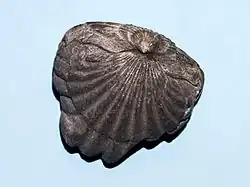
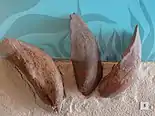
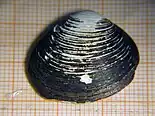
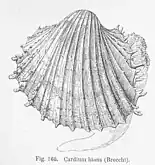

.jpeg.webp)

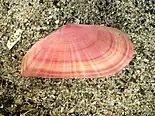
.jpeg.webp)


.jpeg.webp)
